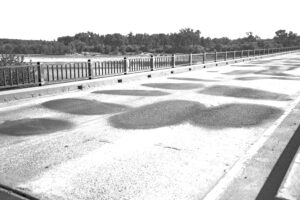
Here, quality of patch work all along the Yellowstone River bridge near Huntley raises safety concerns from local residents for vehicles and those traveling over the bridge. This photo was taken August 14, 2024 as the rough surface continues to concern passersby. (Gage McNiven photo)
Community members lament the aging Huntley/Shepherd bridge repairs, with many wondering if the cracks were better than the repairs. Walt Houghton, Maintenance Chief of DOT Billings Division, has communicated that repair options are limited, and they are attempting stave off the elements until the bridge’s scheduled replacement in the next couple years.
The Highway 312 Bridge over the Yellowstone River in Huntley was built in 1949, and in November 2023 was nominated for replacement, entering the planning stages. In October this year the Montana Department of transportation (MDT) will meet and decide on its Tentative Construction Plan and whether HWY-312 bridge has found the funding and support needed to make it into the five-year plan. In the meantime, MDT is attempting to maintain the bridge using industry standard patching methods.
According to Walt Houghton, the Velocity-Patch system used on the bridge is the best option the seal cracks on the bridge, otherwise moisture may enter the deck and cause further damage. With winter coming, freezing and thawing ice may further compromise the bridge’s already fractured surface without a proper seal. Houghton explained that the patches laid at the beginning of this summer have produced expected bumps on the bridge and are an unfortunate side effect of maintaining such an old bridge. These patches were left to be compacted by traffic and were then scraped by Houghton’s teams a few weeks later to lower the prevalence of the bumps. The repairs were then left again to be compacted by traffic before being scraped a final time on 8/2/24. Houghton explained that patching maintenance on the bridge is functionally complete, and no further scraping will be done as any scraping at this point may begin to tear up the patches themselves, or worse, the concrete decking they hold together. Houghton also says that while there is another patching method used to seal cracks in bridge concrete it is slower to implement and would still leave bumps similar to the fix already used.
While it seems like resurfacing of the bridge could be a possible alternative, Houghton stated that the state is hesitant to add more weight to such an old bridge. Houghton says there is little the state can do until the bridge reaches its scheduled replacement, and that his team is relegated to doing their best to maintaining a tired bridge.

